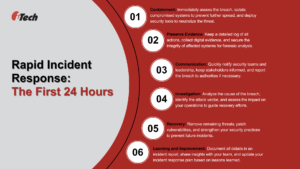Rapid Incident Response: The First 24 Hours

You’ve learned how to assess Third Party Vendor Risk and build an Incident Response Plan in a scalable style. So, when a breach does happen, having done all of this preparation can come in handy, but what is much more important is the quickness and preparedness to respond. For the first 24 hours, time is your friend. It could mean distinguishing between containment or escalation to a business continuity function.
Story So Far: Planning & No Action
Thus, in today’s discussion, we will take you through every step of the incident response process regarding a successful 24-hour first. This includes containment strategies that stop the breach and the preservation of critical evidence to help in a full-scale investigation. View the immediate effects of a data breach and how to use that time well within 24 hours of becoming breached to mitigate damage and keep your business operational.
So, let’s begin!
- Containment: Your First Line of Defense
When your organization is breached, containment should be at the top of the priority list. Here is an analogy: When your ship has a leak, you do not ask why it started leaking in the first place but instead focus on plugging that hole. The same is true for a breach.
Critical Steps in Containment:
- Identify the Source and Scope of the Breach: First things first! Find out what was actually broken into, which systems have been affected, and how far the attackers managed to get. This can guide which containment efforts you choose.
- Isolate Systems: Once you have determined the infected systems, remove them from the network. It effectively keeps the breach from extending through your network. Taking an example of the Swift Global Bank Heist Incident: Attackers attempted to steal nearly $1 billion from Bangladesh’s New York Federal Reserve account. However, swift action to stop unauthorized transactions reportedly limited the damage by a huge amount.
- Block Further Attacks: To block ongoing attacks, use security solutions like Next-Gen Firewalls (NGFW) and Endpoint Detection and Response (EDR) tools. These are your spam filters, blocking the way of undesired traffic.
- Evidence Retention: Building a Solid Case
After the breach has been contained, your second step is evidence retention. Why? You need to understand who, what, and how the data breach happened to prevent future attempts as well as for any lawsuits.
Proper Ways to Retain Evidence:
- Document Every Step Taken: Once the breach has been discovered, start a log tracking every measure taken. Write down the date, time, respondent, and what was done. For posterity, never mind any post-mortem analysis in case of subsequent legal proceedings.
- Collecting Digital Evidence: Gather log files, suspicious emails, files, communication records, etc. Forensics experts can follow the digital trail left during this breach to ascertain how it happened. Take the Target Data Breach, for instance. Target cooperated with law enforcement and forensic experts to stop the operation of this ring before it could carry on with further fraudulent activities.
- Ensure Evidence Integrity: Do not tamper with compromised systems until experts assess them. Changing anything might obliterate important evidence, making it unclear what happened and who should be in charge of the situation.
- Communication: Keeping Everyone in the Loop
Having an effective way to communicate what is going on during incident response isn’t just about implementing tech fixes; it also encompasses communication. Everyone from your internal teams to external stakeholders must be kept in the loop. It is important to communicate effectively & often and be very clear when directing others, which helps everyone stay on the same page and build a trustworthy relationship.
Best Practices in Communication:
- Immediately Notify Your Security Team: Incident response, IT staff, and higher management must be informed of a breach—speed results in quicker action.
- Notify Stakeholders: You must inform your employees, clients, and business partners about the breach. Be honest, tell them how it happened and why it impacts their lives, and tell them what you are doing to fix the problem.
- Report to Authorities: If the breach involves sensitive data or criminal activity, you should report it to the authorities. A great example is the Anthem Data Breach. Anthem rapidly alerted law enforcement and affected individuals to minimize the worst consequences.
- Root Cause Analysis: Why Did This Happen
When you’re beyond the initial response, you need to drill down. As urgent as it is to patch the hole, knowing how this breach happened in the first place is equally important. One factor is that you can only mend what was broken if it’s clear why.
Breach Investigation Steps:
- Find the Root Cause: This is when you inspect all evidence to determine what caused the breach. Was it a phishing email? An unpatched vulnerability? Of course, the only way to prevent this from happening again is to understand what caused it.
- Understand the Attack Vector: Learn how attackers got through. By discovering whether it was a weak password or an advanced malware attack, you are able to reinforce the vulnerability point.
- Investigate the Impact: Evaluate what data was stolen, how operations were negatively affected, and the financial impact. Only after conducting a thorough review will you be able to assess the extent of the breach and begin your next steps.
- Recovery: Getting Back to Business
Now that you know who, what, and how the attack was carried out on your systems, your focus should be to get everything back online. The sooner you can get back to business as usual, the better.
Key Recovery Steps:
- Remove Malicious Threats: Leverage security technologies to eradicate any existing malware or other threats on your network. This is the normal checklist: remove and reset any security permissions that might have changed during the breach.
- Correct Vulnerabilities: Ensure you rectify any critical vulnerabilities that would otherwise allow such a breach. There’s no point in rebooting if you’re still vulnerable.
- Improve Security: Now is the time to improve your defenses. Whether that means improved staff training, new security technology investments, or fine-tuning your incident response plan — all will make you more secure and resilient.
- Learn and Improve: Strengthening Your Defenses
The last stage of the incident response process is learning from the breach and improving defenses. Every incident is a learning process, so learn from your mistakes and improve your security to be ready for the next one.
How to Learn and Get Better:
- Craft an Extensive Incident Report: Capture all details of the breach: what happened, your response, and lessons learned. This report will be useful in the future to prevent similar incidents.
- Pass on Knowledge of Mistakes: Don’t hoard your results. Teach your team and other stakeholders what you’ve learned. This will help everyone be more prepared for the next one.
- Overhaul the Incident Response Plan: Adjust your incident response plan as well. This is the first step in forging stronger cybersecurity since you must rely on something other than what worked yesterday to work tomorrow.
Summary: Is Your Crisis Readiness Warmed Up?
After a security breach is uncovered, your actions matter the most in those first 24 hours. You now know how to contain the breach, preserve evidence, communicate effectively, and begin your recovery.

But keep in mind that having a plan is halfway there. Whatever the concern, your organization must have both operational awareness and the capability for rapid response. This is the kind of readiness you need.
That’s where we come in. At iTech GRC, using IBM OpenPages, we help our clients navigate incident response. Our security analysts with significant experience leverage modern tools and build tactics and strategies tailored to secure your organization from current and future threats.
So, what’s next? Please don’t wait until it’s too late. Schedule a free consultation with one of our professionals today to find out how iTech can help make your corporation stronger and safer.
And also, if we missed something or you have any feedback, please drop your comment. We’re all ears!
